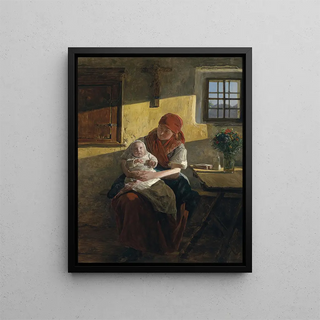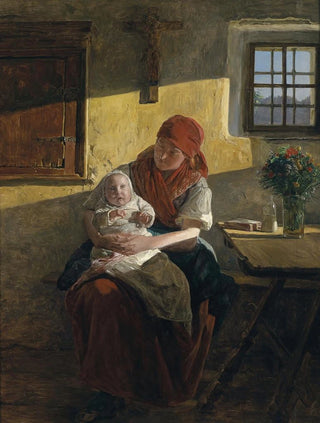Painting Repos du dimanche - Ferdinand Georg Waldmüller | Art print


View from behind

Frame (optional)
Reproduction Repos du dimanche - Ferdinand Georg Waldmüller – Engaging Introduction
In the rich and diverse universe of art, some works manage to capture the very essence of everyday life while revealing deep and universal emotions. "Repos du dimanche - Ferdinand Georg Waldmüller" is a perfect example. This painting, depicting a bucolic scene of Sunday relaxation, invites the viewer to immerse themselves in a moment of serenity and conviviality. The characters, frozen in a moment of sharing, remind us of the beauty of simple moments, echoes of a bygone era when nature and humanity coexisted in harmony. Waldmüller, with his unparalleled talent, manages to transcend time and offer us a window into a world imbued with gentleness.
Style and uniqueness of the work
Ferdinand Georg Waldmüller’s style is distinguished by his ability to blend realism and romanticism. In "Repos du dimanche," every detail is carefully observed, from facial expressions to the delicate nuances of clothing. The warm, luminous colors evoke a peaceful atmosphere, while the skillfully balanced composition guides the eye across the scene. The characters, although frozen, seem to vibrate with an inner life, as if sharing a secret with the viewer. The light filtering through the foliage creates a play of shadows and highlights, enhancing the depth of the work and adding an almost tangible dimension to this scene of repose. Waldmüller succeeds in capturing not only a moment but also an ambiance, a feeling of well-being and tranquility, making this work a true masterpiece.
The artist and his influence
Ferdinand Georg Waldmüller, born in 1793 in Vienna, is often regarded as one of the most important painters of the Austrian Romantic movement. His career is marked by a desire to depict everyday life with increased sensitivity. Influenced by the artistic currents of his time, he quickly established himself as a master of portraiture and genre painting. Waldmüller surrounded himself with a rich palette of influences while developing a style that is uniquely his own, blending meticulous observation with poetic interpretation. His ability

Matte finish

View from behind

Frame (optional)
Reproduction Repos du dimanche - Ferdinand Georg Waldmüller – Engaging Introduction
In the rich and diverse universe of art, some works manage to capture the very essence of everyday life while revealing deep and universal emotions. "Repos du dimanche - Ferdinand Georg Waldmüller" is a perfect example. This painting, depicting a bucolic scene of Sunday relaxation, invites the viewer to immerse themselves in a moment of serenity and conviviality. The characters, frozen in a moment of sharing, remind us of the beauty of simple moments, echoes of a bygone era when nature and humanity coexisted in harmony. Waldmüller, with his unparalleled talent, manages to transcend time and offer us a window into a world imbued with gentleness.
Style and uniqueness of the work
Ferdinand Georg Waldmüller’s style is distinguished by his ability to blend realism and romanticism. In "Repos du dimanche," every detail is carefully observed, from facial expressions to the delicate nuances of clothing. The warm, luminous colors evoke a peaceful atmosphere, while the skillfully balanced composition guides the eye across the scene. The characters, although frozen, seem to vibrate with an inner life, as if sharing a secret with the viewer. The light filtering through the foliage creates a play of shadows and highlights, enhancing the depth of the work and adding an almost tangible dimension to this scene of repose. Waldmüller succeeds in capturing not only a moment but also an ambiance, a feeling of well-being and tranquility, making this work a true masterpiece.
The artist and his influence
Ferdinand Georg Waldmüller, born in 1793 in Vienna, is often regarded as one of the most important painters of the Austrian Romantic movement. His career is marked by a desire to depict everyday life with increased sensitivity. Influenced by the artistic currents of his time, he quickly established himself as a master of portraiture and genre painting. Waldmüller surrounded himself with a rich palette of influences while developing a style that is uniquely his own, blending meticulous observation with poetic interpretation. His ability
12,34 €






